Our memories of France 2024:
It had been a while since we traveled in France. This trip was originally planned as our 40th anniversary (2020) but was delayed due to Covid. While the weather was mixed (and one reason we more often travel to Spain and Italy) the places we stayed were top notch, with great hosts. We enjoyed a number of excellent meals. We have a number of wonderful memories (in no particular order), including:
- feeling like a princess and knight while staying in two 15th century chateaus (Ternay and Vauloges)
- the candlelight breakfasts at Chateau Vauloges
- being served breakfast by Count Loic de Ternay
- the extensive breakfasts enjoyed outdoors at Le Manoir de Nabinaud
- the always fresh breakfast croissants
- discussing living in France with Tina at Chevalier Noir
- conversations with the guests (Gail, John, Carsten, Lela and the Greek lady) at La Barde de Montfort
- our 'anniversary' dinner at Chateau de Vauloge, including the 'sparkling' tiramisu for dessert
- the owl butterflies in Chateau de Ternay's woodsy park
- the frogs at La Barde de Montfort and Chateau de Vauloge
- our 'picnic dinners' at Le Manoir de Nabinaud, Chateau de Ternay and our Gite at Les Bruhasses
- visiting Hans and Sam, and reconnecting (via Messenger) with Miranda
- owners sharing their personal stories of how they came to become proprietors of their lodgings
- the generations of Loic's family history at Ternay
- the restoration of the ruins and church of the 9th century Abbaye Saint-Pierre in Marchilac-sur-Cele
- the popularity and crowds at the Monet Gardens resulting in us deciding not to visit
- dinners cooked for us by Florence (Maison Ardure); Paul (Chevalier Noir) and Micol (Chateau Vauloges)
- the beautiful river valleys - the Lot; the Tern; the Gers; the Dordogne; the Cele; the Sarthe
- Gayle's girls - the free range chickens at Le Manoir de Nabinaud
- being invited to an apero / informal Argentinian tango performance
- desserts off our list - creme brule, chocolate mouse and profiteroles, crepes
- typical French dishes - cassoulet, duck, crepes / galettes, escargots, grenouilles, omelette, quiche
- apertifs, especially Kir peche and Kir cassis
- the mediocre weather
- Joanne taking Gayle on a tour of her gardens
- the fortified village of Larressingle
- ice cream and sorbet stops
- the dog at Ternay falling asleep on Gayle's lap
- the beautiful rolling French countryside
- the many small, quaint, pretty villages
- Gayle's burrata dish at La Cabane
- the absence of sunflowers in bloom
- a new appreciation for rose wine
- the tree canopied rural roads
- our wonderful hosts - too many to mention
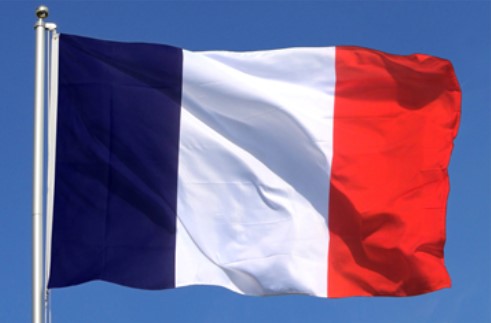
- apertifs, especially Kir peche and Kir cassis
- the impressive fortified medieval town of Cordes-sur-Ciel
- the gardens we visited - Coursiana; Marqueyssac and Chateau de Rivau
- the town of Romieu, the stone cats and the legend of Angeline
- the poorly signed roads in the French countryside
- the flowers everywhere - gardens, formal and informal; villages; homes; roadside ditches
Expenses (based on average exchange rate 1 euro = $1.4783 Cdn):
Here are the costs of our 24 day trip:
$ 2,116 airfare to / from France; seat selection
$ 5,492 lodging ($229 Cdn $ per night)
$ 2,548 food ($106 Cdn $ per day for dinner etc. including wine; breakfasts are included in lodging)
$ 1,914 vehicle ($1,412 or $59 per day for the vehicle, incl. one way drop-off; fuel and tolls of $502)
$ 0 souvenirs
$ 147 entrance - gardens and Roman ruins
$ 212 miscellaneous
$12,429 for 24 days
The total cost excluding airfare and souvenirs (i.e. lodging, food, entrances, vehicle and miscellaneous) was $10,313 or $430 per day.
Following are the average costs of this and a number of previous trips:
Total Lodging Food Vehicle
Spain
2017 $ 408 160 euros / $ 250 63 euros / $ 93 $ 28
2018 $ 380 146 euros / $ 229 60 euros / $ 93 $ 26
2019 $ 375 146 euros / $ 227 68 euros / $104 $ 22
2023 $ 423 180 euros / $ 266 79 euros / $115 $ 28
2024 $ 527 204 euros / $ 300 77 euros / $113 $ 68
Italy
2018 $ 348 127 euros / $ 197 60 euros / $93 $ 23
2022 $ 408 138 euros / $ 195 60 euros / $85 $101
France
2024 $ 430 155 euros / $ 229 72 euros / $106 $ 59
The cost of this trip was more in line with previous trips to Italy and Spain (except Spain 2024 where our lodging costs were considerably higher). We do tend to choose more expensive (although not the most) rooms, and this trip we stayed in three chateaus - Ternay, Vauloges and Rapee, each of which come with a price. Food - essentially dinner with wine - costs have been reasonably consistent over the years, increasing more or less with inflation. The one spike is the huge increase in car rentals post Covid (except Spain 2023). The cost did include a one-way charge accounting for $10 of the total daily cost.
Our lodging ranged from a low of 100 euros to a high of 221 euros. All included excellent breakfasts.
Here is where we stayed, the amount we paid (in euros) the range of room rates and links to websites.
159 euros (139 to 179) Maison Ardure Terraube www.maisonardure.com
133* euros (105 to 115) Les Bruhasses Condom www.lesbruhasses.com
170 euros (130 to 170) Chevalier Noir Cordes-sur-Ciel www.lechevaliernoir.com
150 euros (140 to 155) Mas Garrigue Calvignac www.masdegarrigue.com
100 euros (100 to 135) La Barde de Montfort Vitrac www.lebardedemontfort.com
125 euros (125 to 125) Le Manoir de Nabinaud Nabinaud www.manoirdenabinaud.com
160 euros (150 to 160) Chateau de Ternay Ternay www.chateaudeternay.com
221 euros (196 to 221)** Chateau de Vauloge Ferce-sur-Sarthe www.chateaudevauloge.com
180 euros (140 to 180) Chateau de la Rapee Gisors www.chateaudelarapee.com
* 115 euro for Gite plus 18 euro (9 euro each) for breakfast
** includes 15% discount for three night stay
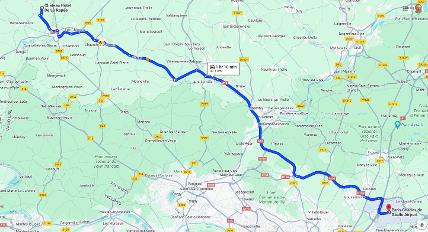
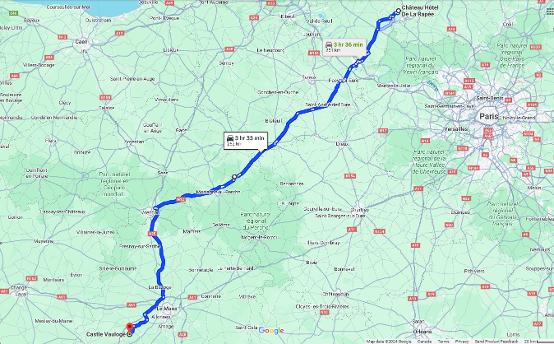
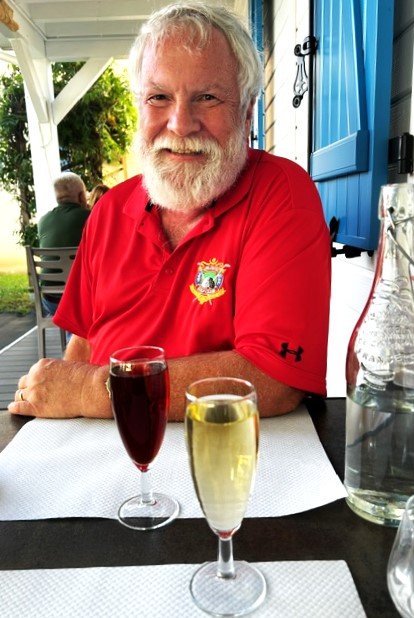
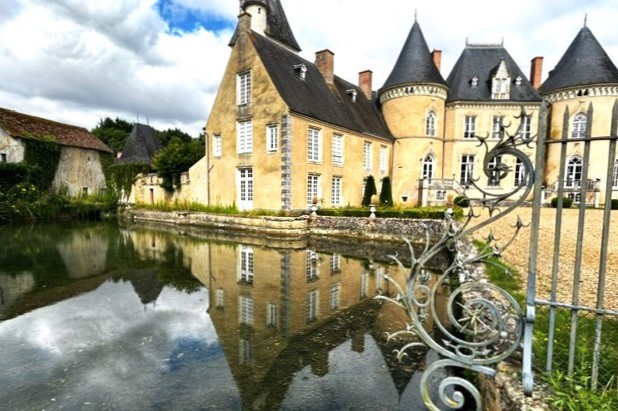
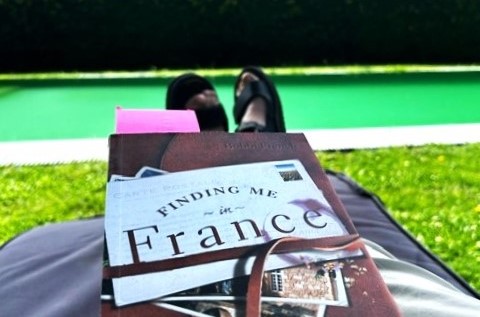
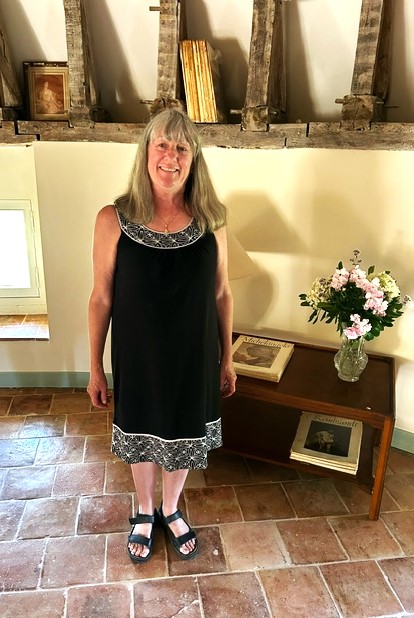
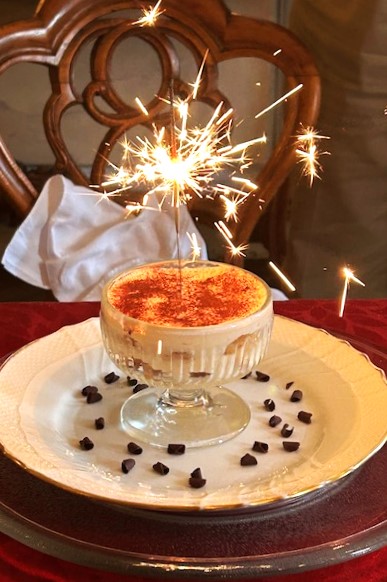
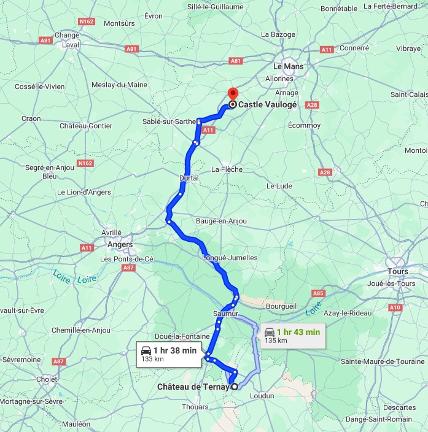
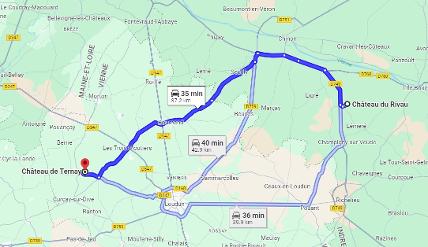
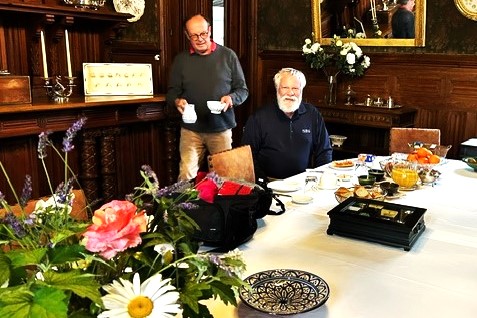
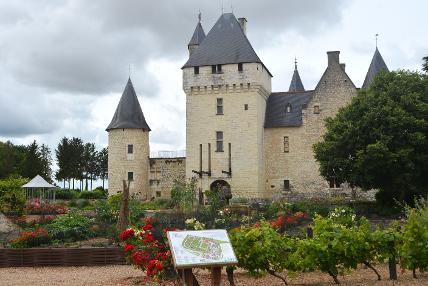
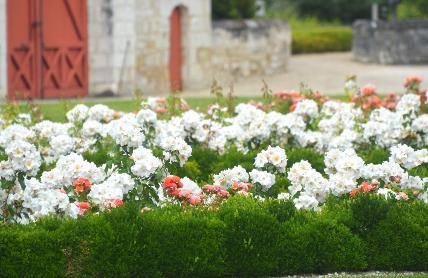
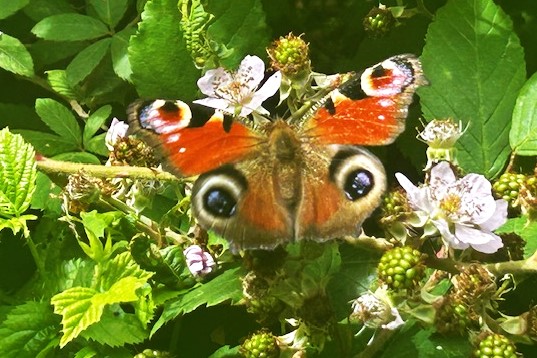

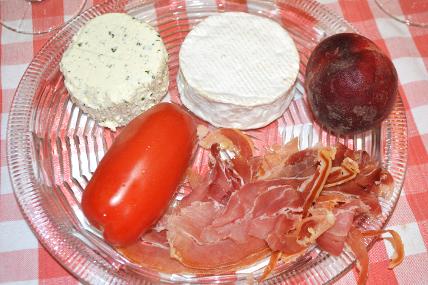
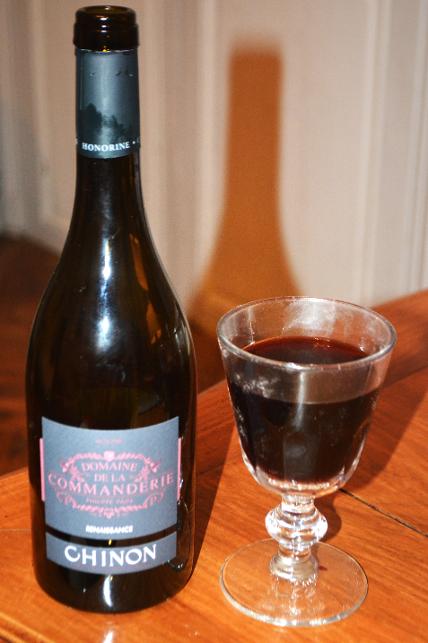
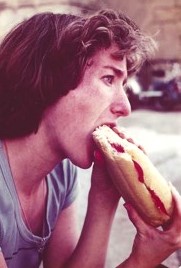
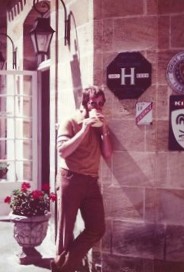
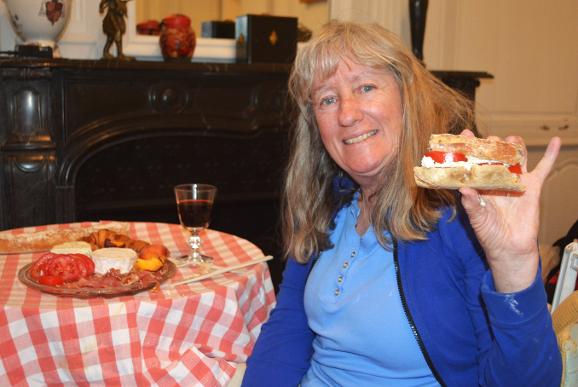
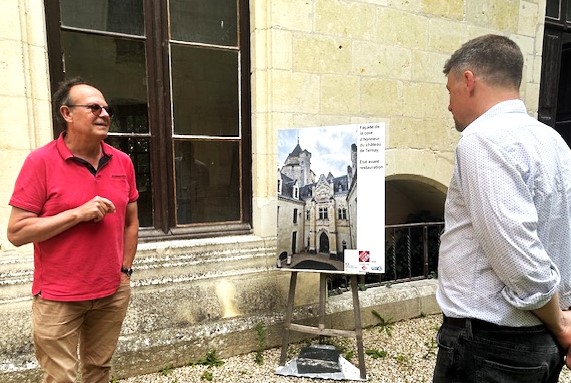
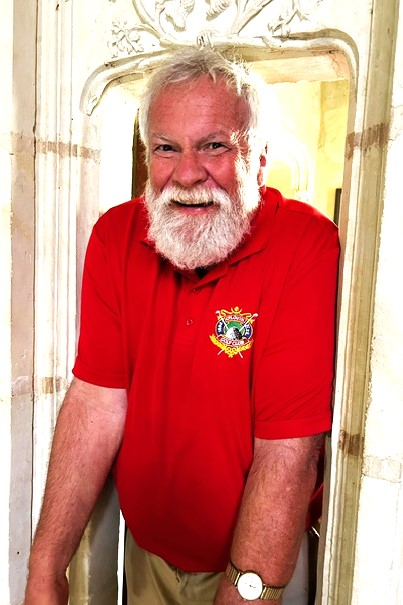
Below: not sure what this was but Loic spent a great deal of time describing it to the other fellow on the tour.
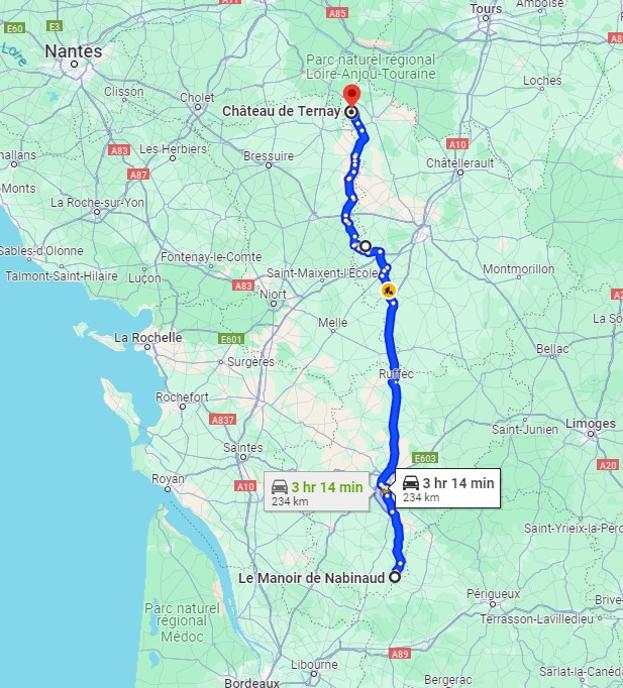
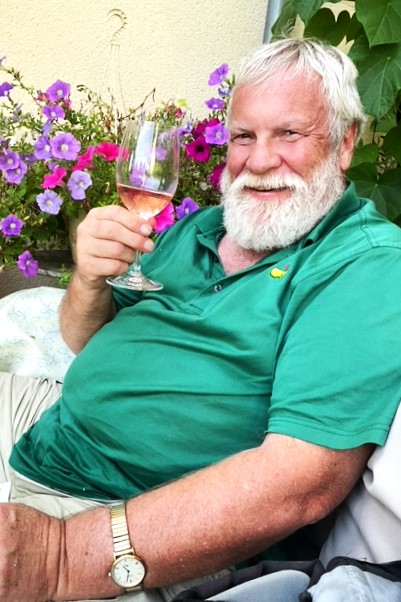
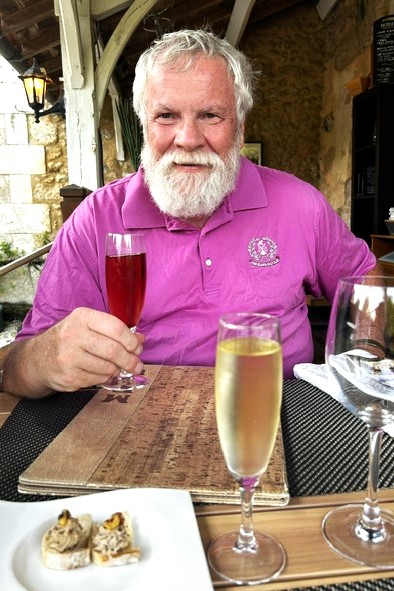
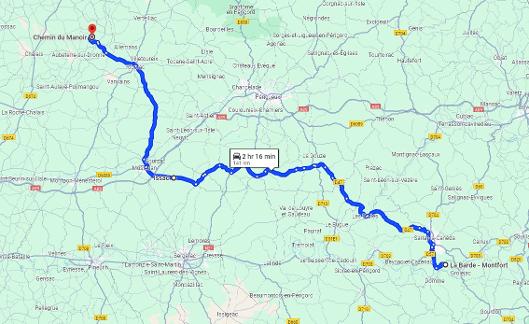
Today was hot! Well into the mid 30s and actually 46 C when we first got into the car. A perfect day for some pool time.
But first another animated and enjoyable breakfast with other guests. There was John and Gail (from Niagara-on-the-Lake, Ontario) who were off to their son's wedding celebration, the couple from Athens with whom we chatted a lot about the islands each of us have been too - we concluded we have actually been to more - and Carsten and Greta, half the German family.
Our original plan was to go to Sarlat but given it was market day during which we expected it to be very crowded with parking near impossible combined with the heat we decided to defer our stop in Sarlat until tomorrow. Rather we decided to visit the nearby Marqueyssac Gardens. The gardens, listed as a National Historical Monument surround a stone-tiled chateau from the end of the 17th C. It was built by Bertrand Vernet de Marqueyssac, Counselor to Louis XIV. The romantic and picturesque gardens offer over 6 km of pathways surrounded by over 150,000 hand pruned boxwoods, with viewpoints, rockeries and stone cabins. Situated on a rocky spur, the viewpoint offers one of the most impressive panoramic views of the valley and its many chateaus. Since 1997 the gardens have been classified amongst the 'Notable Gardens in France' by the Committee of Parks and Gardens of the French Ministry of Culture. Marqueyssac is the most visited garden in the South-West of France.
Not your typical gardens - there were virtually no flowers and therefore little colour other than the beautiful peacock. It was nice to slowly meander under the shade of the trees on this very hot afternoon. We returned from the far end of the gardens on the complimentary shuttle to enjoy very tasty sherbet in a seating area being sprayed by light mist - very welcome. After our stroll we toured a few rooms of the chateau, with period decorations and paintings.
We returned to La Barde Montfort where we took advantage of the pool. In just one day it did seem warmer than it was yesterday. It was fun watching Greta and Pippa playing with their dad in the pool. We also ordered a bottle of rose wine that we enjoyed both before and with dinner.
We again had dinner at La Barde, tonight with the Germans - Lela, Carsten, Greta (5) and Pippa (3 1/2) from Hamburg near the Baltic Sea. Thanks to their very good English we chatted extensively during the meal. The girls were particularly good throughout. We started with an amuse-bouche of avocado and something (not sure what) on toast. For a starter Norm had an excellent ceviche of truite followed by pork filet mignon with a zucchini wrapped roll of vegetables and the creamiest mashed potatoes. Gayle had a poached egg and mushroom in herbs dish in place of the pork. For dessert simple but tasty strawberries with ice cream. So good. Another very enjoyable dinner that spanned a number of hours.
A portion of the gardens.
Gayle having some swing time.
Gayle's poached egg and veggies wrapped in zucchini with the creamiest mashed potatoes.
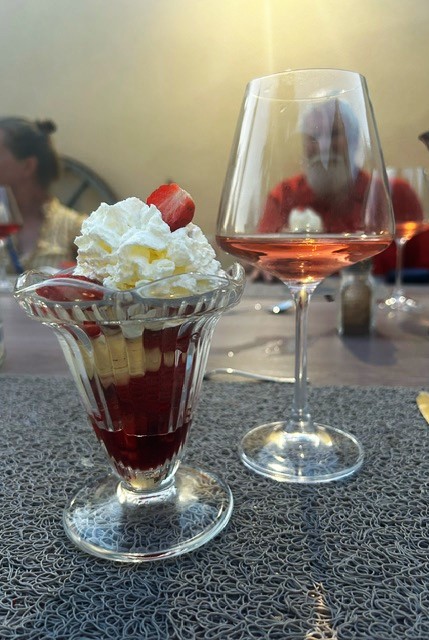
A quiet pretty much do nothing day.
By the time we got down for breakfast the French couple with whom we had had dinner last night had come and gone - out for another day of activities. However we met a couple (Gail and John) from Niagara Falls who were staying at La Barde de Montfort for a couple of days before off to a nearby chateau for one of their son's wedding celebration. We also met a German couple with their two little girls and a couple from Athens. It was nice to interact with others from various countries.
Breakfast was nice with a good selection of meat and cheese in addition to all the standard items.
After a relaxing morning, including time spent sitting at the nearby frog pond watching the cute little fellows / gals, we strolled into the nearby (only 250 metres) village of Montfort to check out the village and the castle. The village of Montfort has always been a strategic place throughout the centuries. The castle was first mentioned in 1214 with its first owner being the terrible Catharine Bernard de Casnac, who ran away in front of invading troops who then demolished the castle. Over the years the castle was demolished and rebuilt several times. There have been many owners with the castle still being privately owned. As such it cannot be visited by the general public, but rather only admired from the outside.
We returned to La Barde de Montfort where we had our first swim of the trip. Perhaps a bit chilly but on a day where temperatures soared to over 30 we welcomed the opportunity to cool off. We also spent some time chatting with Carsten, the German fellow and enjoyed his girls (Greta and Pippa) playing in the pool, including taking their job of saving the ladybugs very seriously.
For dinner we went to the nearby village of Vitrac where we found a restaurant, the Cafe des Arts in the old schoolhouse (and patio outside where we ate) that served crepes or Galette de Ble Noir. Perfect! Gayle had a champignons, emmental and creme fraiche crepe with a salade verte and a glass of vin rose while Norm had the La Forestiere - champignons, emmental, jambon de pays and creme fraiche with an 'upgraded' salad including tomate, cabecou (goat cheese) and basilic with a glass of Citron fraise presse. For dessert we shared a crepe of hot homemade chocolate.
Before the short drive back we saw a number of air balloons floating over the Dordogne river and nearby countryside.
After a short two night stay we packed up and left Mas de Garrigue. What a wonderful stop at a gorgeous property with very friendly owners.
Rather than take the same road up the plateau we drove on to Tour-de-Faure and on to the Cele river and Cabrerets. Having left relatively early and being unable to check in until 5:00 pm we decided to while away some time having a baguette sandwich in the village at a nice patisserie Du Moulin au Fournil. A very nice break during which we caught up on some emails.
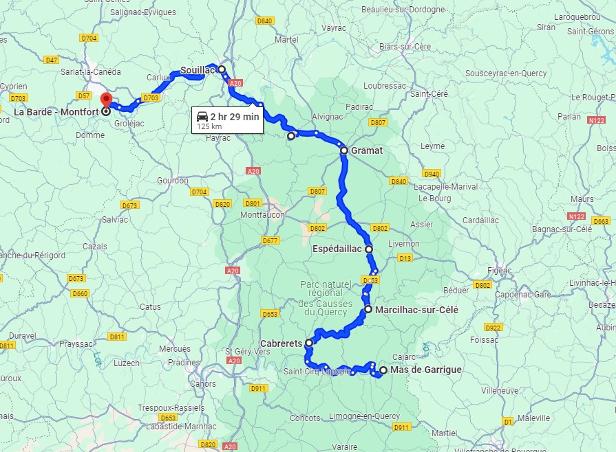
After a quality, albeit perhaps not as extensive as some, breakfast we spent time taking photos of this stunning property. The weather improved today with the sun peeking out. Yet the morning was still somewhat cool. It was nice to sit around the pool but absolutely no thought of going in. Early afternoon we headed out to tour the countryside and take in some of Sarah's suggestions.
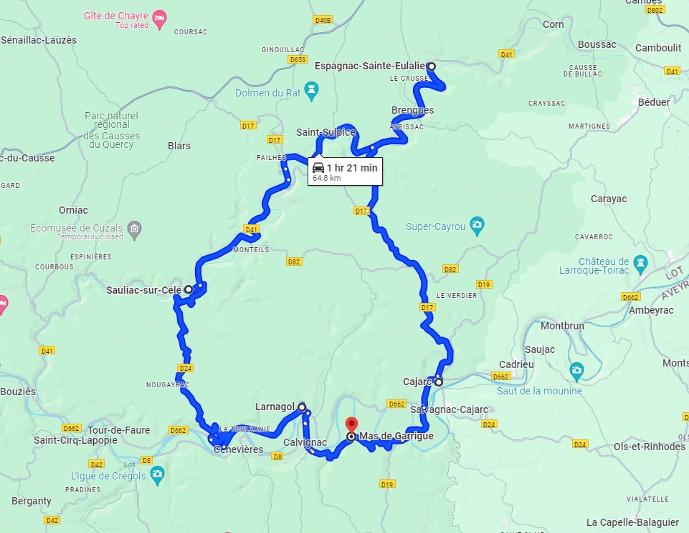
However, the attached Gothic church underwent restoration efforts and stands as a testament to the abbey’s former glory. Adorned with beautiful religious statues the 15th-century wall has a number of frescoes. During times of conflict, such as the Hundred Years War the church provided protection to the local populace. Today, the church hosts monthly Mass and special musical events, offering a glimpse into the rich tapestry of history and spirituality that defines Marcilhac sur Cele.
We returned to Mas Garrigue for a short while before heading out again - to Saint-Cirq-Lopopie, a village of only 200. Perched on a cliff overlooking the Lot the medieval village is dominated by the fortified church, houses with sloping roofs covered with brown tiles lining picturesque cobblestone streets. The village, one of Les Plus Beaux Villages de France won the 'Preferred village in France' competition in 2012. No doubt Saint-Cirq-Lopopie is an interesting, pretty village but somewhat destroyed by the six large parking lots on the outskirts. While not busy when we were there we can't imagine how crowded the village must be in the summer.
We ate dinner at one of the very few restaurants open on a Sunday night - Le Gourmet Quercynois. It was nice to eat outdoors on a terrace overlooking a cobblestone street. We started with an amuse-bouche of a small cup of gazpacho. As a start to his complete meal Norm had a Salad de Cabecou (a local chevre / goat cheese) followed by a traditional dish of southern France - cassoulet that included canard (duck) confit, poitrine de porc, saucisse fraiche, saucisson a l'ail and haricots - lots and lots and lots of white beans. Meanwhile Gayle enjoyed an omelette aux cepes (mushrooms) with a gratin de pomme de terre and a salad. For dessert we shared a Poire Williams - poached in wine of Cahors with cannelle (cinammon) and sorbet poire (pear). Very nice.
Admittedly I took a wrong turn on the drive back detouring 7 km out of our way. There was good and bad to having done so. The good: we ended up in the small village of Lugagnac with its beautifully restored windmill next to a small church. The bad: we missed what looked like a spectacular sunset that no doubt would have been very picturesque over the river.
A short driving / moving day today but first a relaxing morning with Paul and Tina. Paul was in no hurry to have us leave so we worked on our blogs and took our time, knowing we had a relatively short drive north. Unfortunately the day weather-wise was our worst yet with a steady rain throughout the day.
We enjoyed a wonderful stay at Le Chevalier Noir thanks to Paul's hospitality and the friendliness and helpfulness of Tina. Another winning choice.
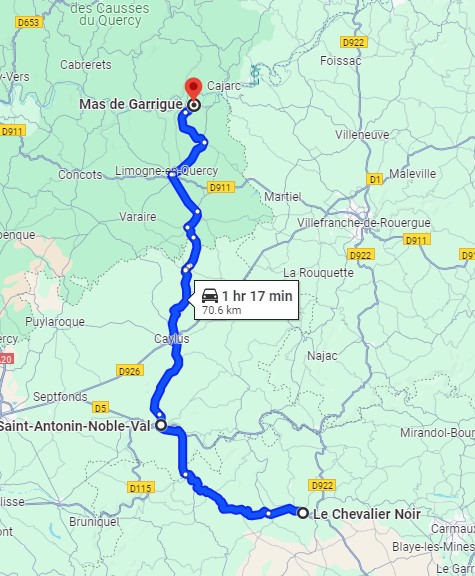
The weather, while still not warm (see Tina's jacket) was nice enough to eat outdoors today. During breakfast we again had a very nice chat with Tina and Paul. Both suggested we head to Albi, 25 kms or so away, to visit the largest brick cathedral in the world and the adjacent Toulouse-Lautrec museum.
The drive to Albi was easy; the parking much less so. It was very busy with every spot occupied until we found one a kilometer away.
From where ever one arrives - the road from Toulouse, Rodez, Millau or Cordes-sur-Ciel the Sainte-Cecile cathedral is dominant. The massive structure is the largest brick cathedral in the world, having the appearance of a fortified castle. It dominates the landscape of the city in a style of southern Gothic (13th century). Its military aspects distinguishe it from contemporary cathedrals in Chartres, Reims and Amiens. Inside is a striking vision of colours, paintings, sculptures and statutes - the first UNESCO World Heritage Site in the Tarn region.
We have said it before but will say it again - to stand inside such a massive structure and imagine how it was constructed back in the day is mind boggling.
The nearby Henri Toulouse-Lautrec museum includes paintings from his youth, scenes from Montmartre, and the world of spectacle / theatre in Paris at the end of the 19th century. Toulouse-Lautrec (1864 - 1901) was a native of Albi. The museum has been housed since 1924 in the Palais de la Berbie, a former castle of the bishops of Albi, built over a 50 plus year timespan from starting in 1228. The palace became a fortress facing the hostility of the Albigensian people, both economically and religiously. Classified as an historic monument in 1862 for its construction and then again in 1965 for its interior elements, ceilings, fireplace and woodwork the palace is quite impressive. It was classified by UNESCO as a world heritage site in 2010, being built of red fairground brick like the adjacent Sainte-Cecile cathedral. In addition to the museum itself there are breathtaking gardens with views across the river Tarn and the old medieval bridge.
We returned to Cordes-sur-Ciel where we went to dinner at another restaurant, Aster, recommended by Paul. Operated by an American from Portland along with his wife (from Bordeaux) we enjoyed an outdoor table adjacent to a flowing brook. We started with a foccacia covered with a thicker Greek style yogourt known as labneh, dried tomatoes, mushrooms and for me jambon. Gayle then had the Courgette ail noir et pommes de terre nouvelle - roasted zucchini with creme de perail (a local cheese), pureed black garlic, almonds and new potatoes. Norm had the confit de canard with lavender honey, spring carrots, a cherry vinaigrette and a sauce of beet root with sage. Very intricate and flavourful cooking. Being the only guests we had the opportunity to have a lengthy chat with Josh, the owner and chef, learning of his journey that brought him to operate a restaurant in Cordes-sur-Ciel.
A busier than normal day but a good one.
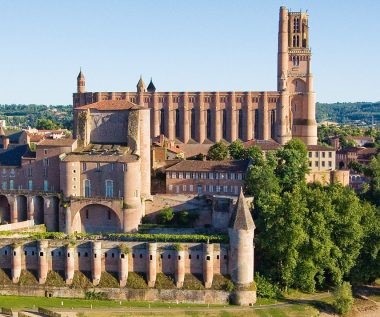
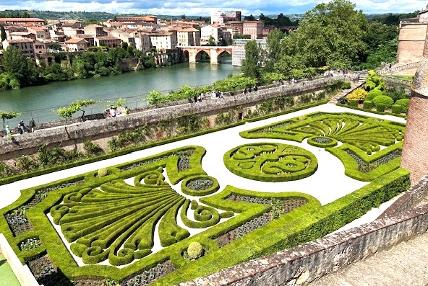
After a wonderful sleep our day started with a lovely breakfast of a baguette, croissants, meats, a selection of cheeses, jams, very tasty fresh tomatoes and yoghurt and / or eggs if one wished, along of course with lots of coffee. Over breakfast we chatted with Paul and Tina - respectively the owner and an American guest who moved to France later in life a number of years ago who is staying at Le Chevalier Noir for a few nights as she moves from one home to another. Both are very friendly. It was interesting to listen to Tina's experiences of having moved permanently to France, as well as her and Paul's suggestions for places to visit and see.
Not being the nicest of days we stayed put for most of it, relaxing after our relatively long travel day yesterday. Later in the afternoon we went up to the original area of what was then called Cordes, dating from the 13th century. Cordes was built between 1222 and 1229 by Raimond VII, the count of Toulouse. The original name - Cordes is believed to be from the word 'corte' meaning 'rocky heights'. In 1993 the town was renamed Cordes-sur-Ciel in consideration of its height above the clouds over the low-lying areas of the valley.
Cordes is generally considered the first of the bastides of Southwest France, bastides being 'new towns' originally conceived to resettle and shelter people displaced during the Crusade. Though not fortified, bastides were often built in defensible locations as was the case with Cordes, high on a hill. In 1271 Cordes became a part of France without having been militarily conquered. In 1436 Cordes was pillaged as part of the Hundred Years' War but the citizens, with their homes within the original 13th-century ramparts escaped heavy damage during the religious wars at the end of the 16th century, with the result being some excellent examples of 13th and14th century Gothic architecture having been preserved.
The town has attracted pilgrims and craftspeople since the 1940s including a number of writers, painters and poets.
Fortunately we had just finished our walkabout when the skies opened and the rain began to fall just as we were returning to our vehicle. Back at Le Chevalier Noir Paul cooked us a lovely meal. Home made humus, shredded carrots with caraway, olives and pickles along with a selection of cheese and meats, including a couple of duck pates to start. Then Gayle enjoyed a pasta dish with vegetable sauce while Norm had a large plate of canard / duck with green beans and potatoes roasted in the duck fat - delicious. All was accompanied by a very nice bottle of local wine. We finished the meal with chocolate molten cakes served with ice cream.
As wonderful as the meal was, and it was, it was equally wonderful chatting with Paul about a broad range of topics, making for an exceptionally memorable evening.
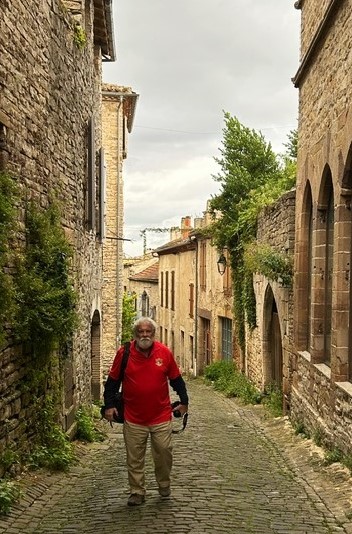
We left Les Bruhasses this morning for the drive east to Cordes-sur-Ciel and Le Chevalier Noir. The drive took us around Lectoure and on to Montabaun, continuing through rural landscapes to Cordes-sur-Ciel.
A relatively long drive of nearly three hours direct - more like five for us - generally along smaller country roads. We made a couple of short stops along the way, first to the small hilltop village of Blaziert just east of Condom and then to the medieval village of Bruniquel as we were approaching Cordes-sur-Ciel.
Bruniquel dates from the end of the 12th century when the village was surrounded by a first fortification wall. There are still elements of the wall, as well as houses from the 15th and 16th centuries.
Being quite a hilly village we chose not to walk to the castle at the top, but did get a nice view from the road below as we were driving out.
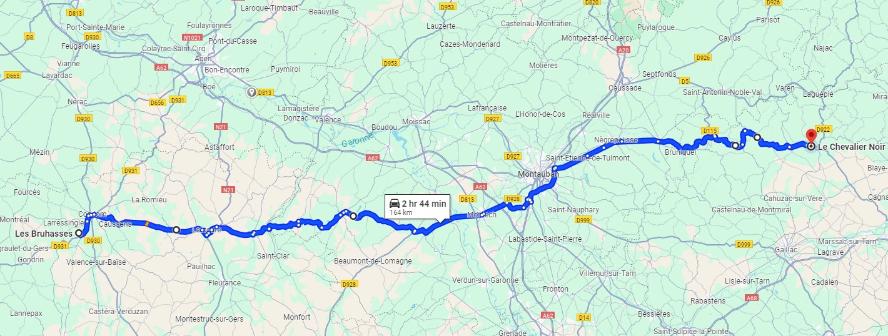
This morning Helene encouraged us to visit the nearby fortified village of Larressingle and then the Roman ruins near Eauze. While we didn't get out until 3:00 ish we did both.
We first visited Larressingle, the smallest fortified village in France with a size of only 270 sq m and a current population (inside the walls) of 10. One of the prettiest villages in the country (Plus Beaux Village de France) the entrance bridge Largigue is listed by UNESCO as a significant monument on the pilgrimage route of Compostela (The Way of St. James).
The fortified village dates back to the 13th century when as many as 300 people crammed inside the walls attached to the ramparts. The church of Saint Sigismund dates to the 12th century, before the castle and fortifications were built. The chateau, now privately owned, was the residence of the Bishops of Condom in the 13th century at which time watch towers and thick fortified walls were built. After the French Revolution during which the church and Chateau were damaged the village was abandoned. It was not until the early 19th century that Larressingle was rediscovered. Eduoard Mortier, the last of the Dukes of Treviso made it his mission to resurrect the village in the 1920s with the financial assistance of friends from Boston, saving the village from further destruction.
Inside the great stone walls the village is incredibly quaint and beautiful. Plants grow alongside astonishing architecture. And perhaps the best part is that being so small it can all be seen in well under and hour, including a stop to enjoy ice cream (cherry for Gayle and both cherry and dark chocolate for Norm). A very worthwhile recommendation and visit.

The Villa de Seviac, covering 6,500 sq m was discovered in the second half of the 19th century by a farmer who had purchased the property. Regular excavations occurred through 1996 when a luxurious Gallo-Roman villa from late Antiquity, built in the second half of the 4th century on top of an older villa was uncovered.
An exceptional set of mosaics, today covering 625 sq m were discovered dating back to the first half of the 5th century. The mosaics are considered so impressive they were classified as a Historic Monument in 1978.
The Villa is also characterized by the existence of vast thermal baths, again from the 5th century. Several redevelopments mark the importance given to them by successive owners. The first baths were modest, dating from the first half of the 2nd century. But successive, more ostentatious renovations including marble coverings and heating of the floors and pools along with a swimming pool decorated with mosaics and marble were subsequently added.
While we don't spend a ton of time in museums these days this was an interesting journey to the past.
_______________
We returned to Les Bruhasses for a couple of hours before heading out to dinner at a restaurant, Le Sarmant, conveniently located on this side of Condom. Gayle enjoyed a large salad of chevre chaud (warm goat cheese) while Norm had a delicious piece of agneau (lamb). Gayle could not resist the creme brulee for dessert.
Sadly it was raining when we returned to Les Bruhasses precluding a glass of wine on our deck but still a very nice day.
- identification and labeling of each tree and shrub, representing nearly 700 species
- creation of a family vegetable garden
- creation of an English garden around the house
- creation of a medicinal plant garden
- a rose garden of several dozen species, and
- a nursery with several varieties of old rose bushes
"In 1338, a little girl called Angeline was born in La Romieu. While she was still very young, both her parents died suddenly, and she was adopted by a kind couple that lived nearby. As Angeline grew, so did her love for cats and there were always a few that followed her wherever she went.
During this time, two years of severe weather caused a famine and the townspeople were hungry. They were searching everywhere for anything that was edible. Soon the village cats started to disappear as the starving villagers resorted to eating cat stew. Angeline was horrified and begged her adoptive parents to let her hide a couple of cats in the attic. They couldn’t say no to the poor child. She had already lost her parents and they didn’t want her to suffer the loss of her beloved cats as well, so they agreed. Since Angeline hid one male and one female, her kitten collection increased steadily.
Finally, to everyone’s relief, the weather improved, crops flourished, and food was again plentiful. But because there hadn’t been any cats to patrol the village streets, the rats had overrun the town and were ravaging the crops. The townspeople held a meeting to try to find a solution. Everyone was surprised but happy when Angeline announced that she had twenty cats (as the cat population in her attic had increased tenfold) and they would be more than happy to help with the rat problem. All were in agreement and the cats were let loose in the village. The rats soon disappeared and the crops were no longer threatened.
Village life returned to normal and Angeline went back to helping her adoptive parents work in the fields, always surrounded by her cats. But as she grew older, something very strange happened to Angeline: people say her face began to take on the appearance of a cat and even her ears transformed into pointed cat ears. A bust of Angeline, looking very cat-like, can be seen on one of the buildings in the village.
Like Angeline’s cats of long ago, it’s Serreau’s cats that are helping La Romieu today. His cat sculptures have become a popular tourist attraction bringing in much needed revenue to the village coffers."
_________________
We returned to Les Bruhasses to find out the restaurant we had planned to go to was unexpectedly closed. We were going to have a 'picnic' tomorrow night so decided to advance it a day. We went out to a nearby grocery store where we bought some cheese (Camembert and chevre), Serrano ham, a tomato, lentil salad, a baguette and a bottle of wine - Brouilly, a cru Beaujolais. We returned to our porch, laid out the table-cloth we brought with us, and the food for an enjoyable 'porch picnic' during a beautiful warm and sunny evening.
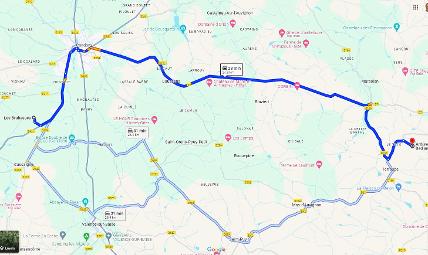
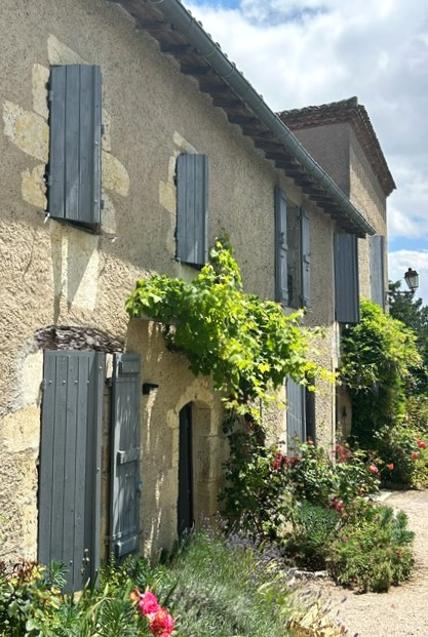
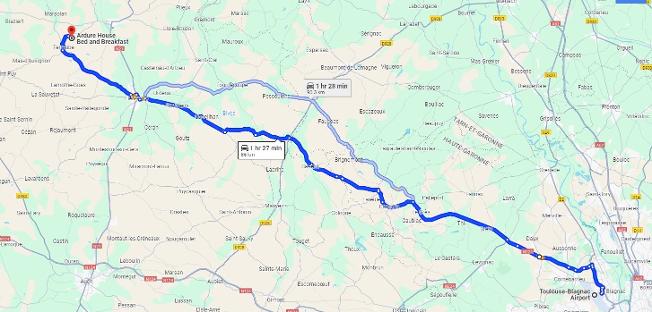
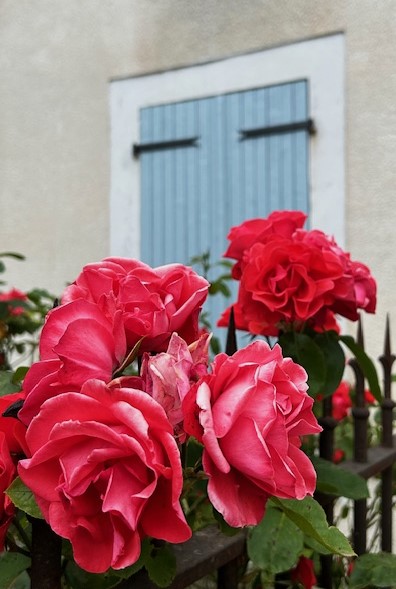
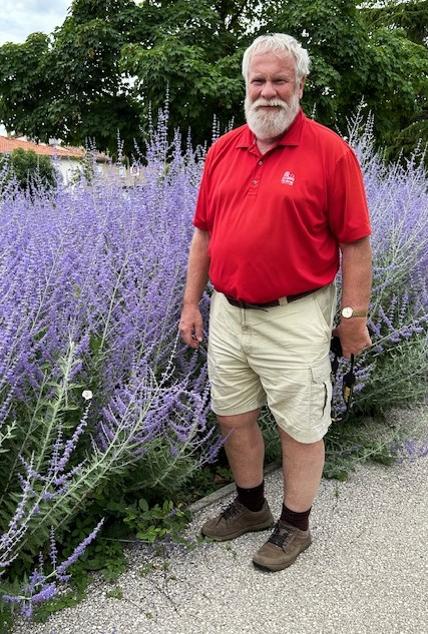
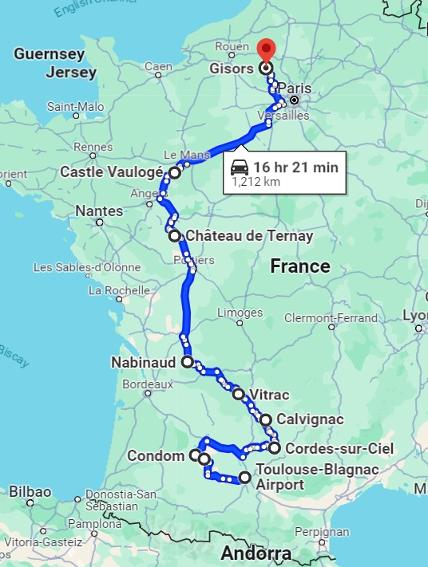
- 2 nights west of Toulouse in the Gers countryside at Maison Ardure, then
- over to Gascony and an 18th century house for 3 nights at Les Bruhasses. We then circle back north of Toulouse for 3 nights in the medieval hilltop village Cordes-sur Ciel at Chevalier Noir
- from there we start to work our way north, first with a 2 night stop at Mas de Garrigue in the heart of the Lot region.
- following will be 3 nights at La Barde Montfort just south of Sarlat in the Dordogne region, where we stayed 44 years ago.
- then it is north-west for 3 nights at Le Manoir de Nabinaud, a small five room B&B
- next the first of two chateaus on our itinerary - Chateau de Ternay for 3 nights, followed by
- the Chateau de Vauloges, near Le Mans also for 3 nights. This chateau was going to be our first stop back in 2020, and then finally
- 2 nights at the Hotel de la Rapee, in Normandy north of Paris